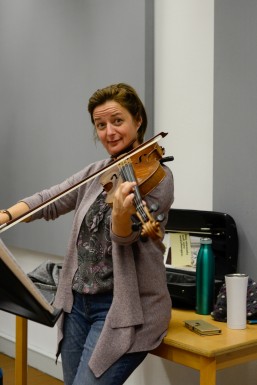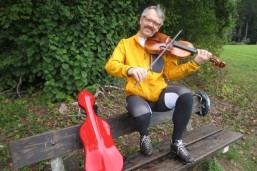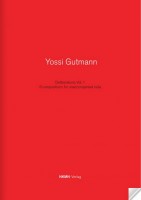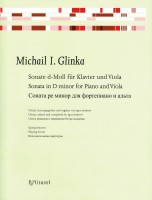
Shifting Attention During Practice – Part 2 |
» Click here to go to part 1
When practicing, one should pay attention to carefully balance listening, perception and cognition. French violist Marion Leleu described this principle in her presentation «Viola Bites», held on March 17, 2020, at the Bach-Musikgymnasium in Berlin.

Pillar 3: Vision
Niklaus Rüegg – Eyesight takes an important position during practicing: Musicians monitor parts of their body while playing (especially arms and hands). A standing mirror also helps observing one’s performance. The trained eye checks for the following:
- Does the bow move parallel to the bridge?
- Is the right upper arm level with the played string?
- Is the bow change executed in a round and wavy gesture?
- Are all joints and articulations actively involved in the movement? The involvement of hand and finger joints is particularly important.
- Does the left wrist extend straight from the arm, or is it bent back or forth?
- Are all lefthand fingers rounded in their specific angles, and are all joints attuned to each other? Are the joints rounded at just the right angle?
- Is the left elbow below the viola, and not unnecessarily trapped?
- The full body statics can also be well monitored in the mirror, especially the compensating movements involved in technical challenges.
- Example 1: During the bow change at the frog, which should happen without the upper body’s dodging to the left.
- Example 2: During upwards or downwards change of positions, without falling back or forth.
- Example 3: See points 3 and 5 above, under Pillar 2 Perception (flexibility of the knee and agility of the pelvis). These perceptions may also be well monitored in the mirror.
All these points are only helpful if one establishes a functioning inner scheme of executing physical movements. For myself, this means that vision may assume a memory function: Once the «right» sound is achieved with a body posture that feels «right», it is worth to observe how that posture looks, so one can repeat and automate this movement as a model.
Pillar 4: Cognition
The above questions lead directly to the fourth pillar, Cognition.
Perception and listening tend to switch off (for brief amounts of time) if a performer feels «in danger». This feeling of endangerment can occur during performance situations, but also through small self-doubt.
Cognition helps with practice, analysis, and development of sound ideas. However, thinking can be counterproductive during performance, and should be shut down to let the playing emerge from a deeper source. Musicians who remain critical and reject their playing during practice, will have trouble accepting themselves during a concert performance. Once performing, the main goal is to establish a flow, through which one feels in harmony, completely active, present, and still relaxed. Listening and perception should dominate the performance, while cognition should remain a «still observant» in the background. As soon as a parameter moves outside the ideal area, cognition will ideally take corrective action, then move back into observing. Performing musicians familiar with the flow can confirm feeling happy and satisfied after such concerts, regardless of audience reception. On the other side, musicians tend to feel unfulfilled after concerts during which they kept reflecting about technical challenges, regardless of the number of compliments and flowers received.
Practice Calm and Anxiety-Free
What solutions exist to improve instrumental performance?
The traditional method requires motivation through self-discipline. However, self-imposed pressure is often demotivating and quickly leads to frustration and displeasure; it is furthermore a fertile soil for stage fright. It is more pleasant and rewarding to practice with a conscious and neutral mindset, listening to and feeling oneself with increased intensity. Pursuing this approach helps frame and achieve the ideal sound easier, and the musician develops an understanding of the posture and movement necessary to reach that ideal sound. Marion Leleu: «The necessary calmness and an anxiety-free, benevolent and accepting attitude unlock our full thinking skills and allow us to find ways to improve». One requirement is a precise idea of the ideal sound: «We should be able to recall the ideal sound as precisely and lively as possible. The current state must be accepted without any complacency, completing the puzzle of an anticipated sound idea step by step», wishes Marion Leleu and recommends the following test: To hear a passage «in one’s head» and try to achieve the best possible sound, the perfect intonation and hearing the exact timbre as imagined. The «ideal state» is then compared with the «present state».
Step by Step Towards the Ideal Sound
To develop an internal sound idea is difficult and requires much practice. The inner ear starts out working fragmentary, and certain notes and rhythms can be difficult to imagine. One possibly strategy is to work with several sound and video recordings, then compare them to the notation. This path allows to develop one’s taste and develop a personal, «internalized» version of a musical work. In a second step, the exercise may be practiced without tone, only through watching the note in question. Abstracting further, the musician may put aside the sheet music and just imagine the music internally. These steps allow conclusions about the effects of certain movements.
Marion Leleu knows what matters during practice and performance: «Be your own best coach, teacher and friend during practice. This approach strengthens and encourages you to stay in the moment, actively listen and perceive, create and share all these beautiful flow moments on stage with the audience».
More blog posts for you |
Interested in more blog posts?

Sheet Music Service |
Sheet music for download
Discover our sheet music, which you can download as PDF, print it out and start playing immediately. Have fun discovering them!» click here for sheet music donloads
» click here for free downloads

(1945, Swiss)
Oraison Irlandaise
Duo op. 156 Nr. 6
for two violas
» to the download

(1947–2019, Israel)
Deliberations Vol. 1
for Viola
Free of charge
» to the download
Printed sheet music

(1804–1857)
Sonata d-minor
for Piano and Viola
Urtext, edited and
completed by
Igor Andreev
» to the edition

(1962)
Fünf kleine Stücke
(Five little pieces)
for Viola and Piano
» to this edition
» to the download
Viola Newsletter |
 Do you don't want to miss any news regarding viola anymore? Our monthly viola news letter will keep you informed.
Do you don't want to miss any news regarding viola anymore? Our monthly viola news letter will keep you informed.
» Subscribe to our viola newsletter for free
|
|
 Visit and like us on Facebook.
Visit and like us on Facebook.
» Music4Viola on Facebook